A list of guards
What are guards?
Guards are usually one of the first things a medieval fencing manual teaches. In essence the guards are positions in which one can hold the sword before the actual exchange of cuts, thrusts and blocks starts. The German terms Hut and Leger suggest that these positions are really assumed and held (they have a connotation of waiting for something to happen), the Italian posta however has no such connotation and both Fiore and Meyer would advise a fencer to actually not remain in a guard for an extended period of time, especially Meyer is very clear on the point:
As far as the guards are concerned, I don't want that one remains long in one of them (1)
So - sometimes guards are just meant transient points that mark the starting and ending position of a cut, sometimes they are really meant as useful positions from which to start an exchange.
Conceptually one can distinguish cutting guards from thrusting guards based on what is biomechanically the straightforward action from a position. If merely extending the hands yields a valid thrust because the point is already aimed at the opponent, one deals with a thrusting guard, if the position is natural to strike an ascending or descending cut, then the position is a cutting guard.
There are few named positions which accomplish neither particularly well - this means they are not useful as positions to start an exchange and merely can occur transiently during an exchange.
Most guards have a left and a right version (classified according to which side of the body the sword is held) but not all fencing systems consider both variants useful.
The same - or not?
Looking at the manuscripts and comparing across different fencing systems, it is sometimes not easy to decide whether any given guard is essentially 'the same' as a guard described elsewhere or not. For instance, consider the following two illustrations of Fiore's right posta di donna:
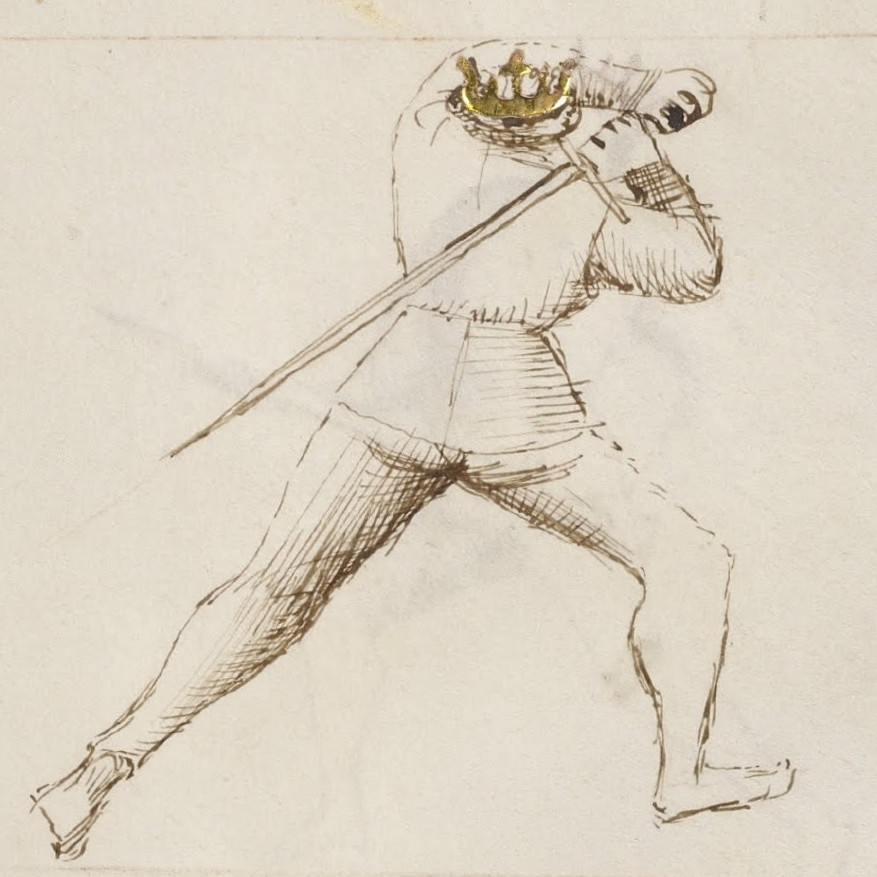 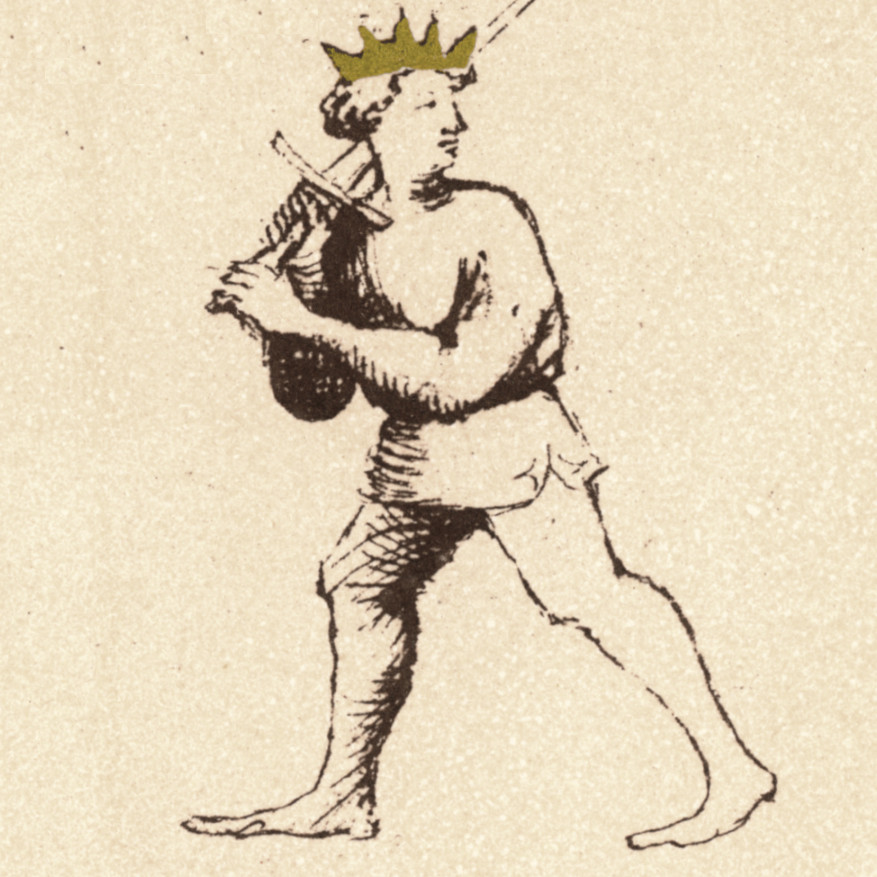 In both cases the fencer has the sword across the right shoulder and has the body turned away from the direction of the intended strike, but the position of the sword is rather different, in one case the tip faces down, in the other up. Also the amount of body tension is clearly not the same. This seems to suggest that there is some leeway in how exactly the guard is done, except... consider the following illustrations which are supposed to show two different guards:
In both cases the fencer has the sword across the right shoulder and has the body turned away from the direction of the intended strike, but the position of the sword is rather different, in one case the tip faces down, in the other up. Also the amount of body tension is clearly not the same. This seems to suggest that there is some leeway in how exactly the guard is done, except... consider the following illustrations which are supposed to show two different guards:
 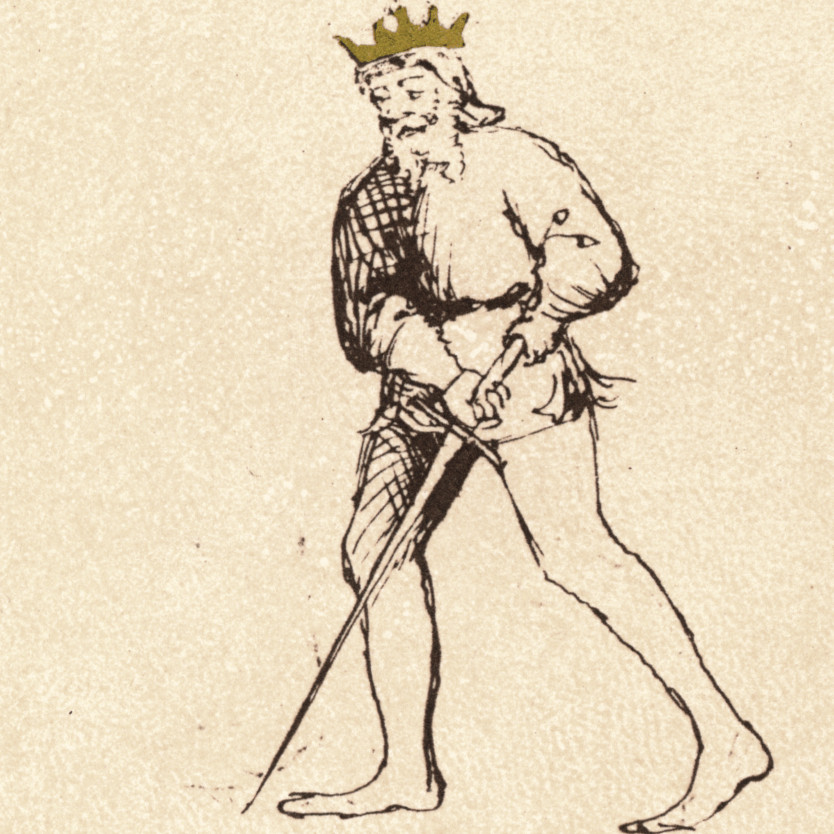 To the left is porta di ferro mezzana ('middle iron gate') and to the right is dente di cenghiaro ('boar's tusk') - the only difference that now warrants a new name for the position is that the sword is pulled a little back.
For that reason, a rather pragmatic approach is adopted here - if more or less the same things can be done from two depicted or described guards, then they are classified as essentially the same guard (even if they have a different name) and small differences in body posture or direction of the tip are seen as matters of style rather than function.
To the left is porta di ferro mezzana ('middle iron gate') and to the right is dente di cenghiaro ('boar's tusk') - the only difference that now warrants a new name for the position is that the sword is pulled a little back.
For that reason, a rather pragmatic approach is adopted here - if more or less the same things can be done from two depicted or described guards, then they are classified as essentially the same guard (even if they have a different name) and small differences in body posture or direction of the tip are seen as matters of style rather than function.
Same language, same guard - different name
Perhaps it is acceptable that some fencing masters mark small differences in posture with a different name while others don't. Certainly one can deal with that. But the problem unfortunately runs deeper - sometimes a manuscript has a designation that we know from somewhere else - but applies it to a completely different position. Consider the following examples from Vadi::
 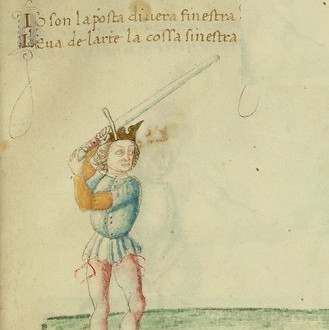 The left text reads I am the guard of the woman, and I am not useless, I often conceal the length of the sword (2) while the right text has I am the guard of the true window According to the art, raise your left leg (3).
The left text reads I am the guard of the woman, and I am not useless, I often conceal the length of the sword (2) while the right text has I am the guard of the true window According to the art, raise your left leg (3).
So posta di donna for Vadi is not at all what Fiore describes with that name, it is a guard in which the sword is held vertically in front of the body while what looks visually like Fiore's posta di donna is called posta di finestra, a name Fiore uses for a completely different guard. This is no mere mislabeling of an illustration, as holding the sword vertically really 'conceals its length.
We're forced to the weird conclusion that two Italian swordsmen talking would not necessarily understand what the other means when a certain guard is mentioned. In other words, the issue is not that each fencing master invented his own terminology, it is that they all used the same terminology but didn't agree on what it all meant.
The same is true for the German fencers - Paurenfeyndt states The first guard is called 'Hochort', or 'Ochs' as the elders did - but of course the subsequent context makes it clear that we're dealing with a high cutting guard, so the term Hochort doesn't replace Ochs, it replaces Vom Tag (and a subsequent play in fact states to cut vom tach).
Such name conflicts have to be resolved somehow when listing guards - generally for the Liechtenauer I will prefer the older manuscripts to the newer ones on the grounds that they are closer to the master and for the Italians Fiore over Vadi on the grounds that Fiore is generally clearer and better organized and conflicting names will be listed extra.
Zornhut
 |
|
Also known as: posta di donna ('position of the lady')
Described by: Fiore, Meyer
Conflicting name: posta di finestra (Vadi)
A cutting guard in which the sword is held behind the swordsman and the whole body acts as a spring. It looks as if the strike would be 'in anger', hence the German name Zornhut 'wrath-guard'. The origin of the Italian designation ('position of the lady') is a bit unclear. A non-dominant side version is used in the Italian, but not much in the German system.
The Italian illustration left seems to show sword across the right shoulder with right foot forward - however another Fiore illustration shows that the swordsman is really facing to strike left and hence has the left food forward (and the body essentially turned backward) - Meyer confirms this.
|
|
Ochs
 |
|
Also known as: posta di fenestra ('position of the window'), Einhorn ('unicorn')
Described by: Fiore, Liechtenauer, Meyer, Vadi
A high thrusting guard in which the sword is held next to the head with the point forward (this requires crossed hands on the dominant side and is not really easy to do in moden sparring gloves). The Italian version is described as instabile which hints that it is assumed only transiently. The German name presumably derives from the horns of an ox, the idea of the Italian name is less clear.
While Einhorn in Meyer's system has been classified here as essentially the same guard, the possible difference to right Ochs also described there is that in Ochs the point is directed towards the face of the opponent, in Einhorn it is higher.
|
|
Langort
 |
|
Also known as: posta longa ('long losition'), posta breve ('short position')
Described by: Fiore, Liechtenauer, Meyer, Vadi
Technically this is a thrusting guard in which the sword is extended towards the opponent. It is not clear that all authors really view this as a guard in the usual sense, especially for Meyer one gets the impression that he views it as a mere transient point that can be reached during an attack.
The name simply means 'long (extended) point'. The Italian system distinguishes a posta breve in which the hands are pulled closer to the body, the German Langort seems to be somewhere in between these two. Tactically the differences are small.
|
|
Posta di bichorno
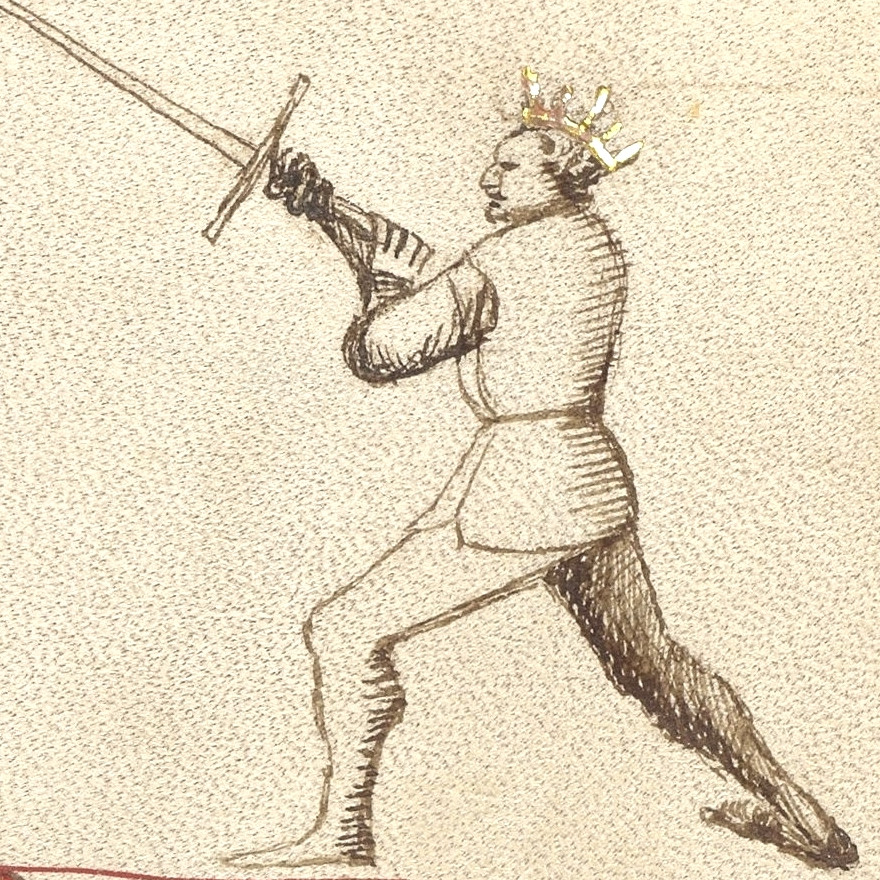 |
|
Also known as: posta sagitaria ('position of the archer') (?)
Described by: Fiore, Vadi
The position differs from the Langort-type guards in that here the handle of the sword is pressed against the lower right arm, thus providing a fairly unyielding blade in a possible bind.
The origin of the name 'two-horned position' is unclear.
|
|
Kron
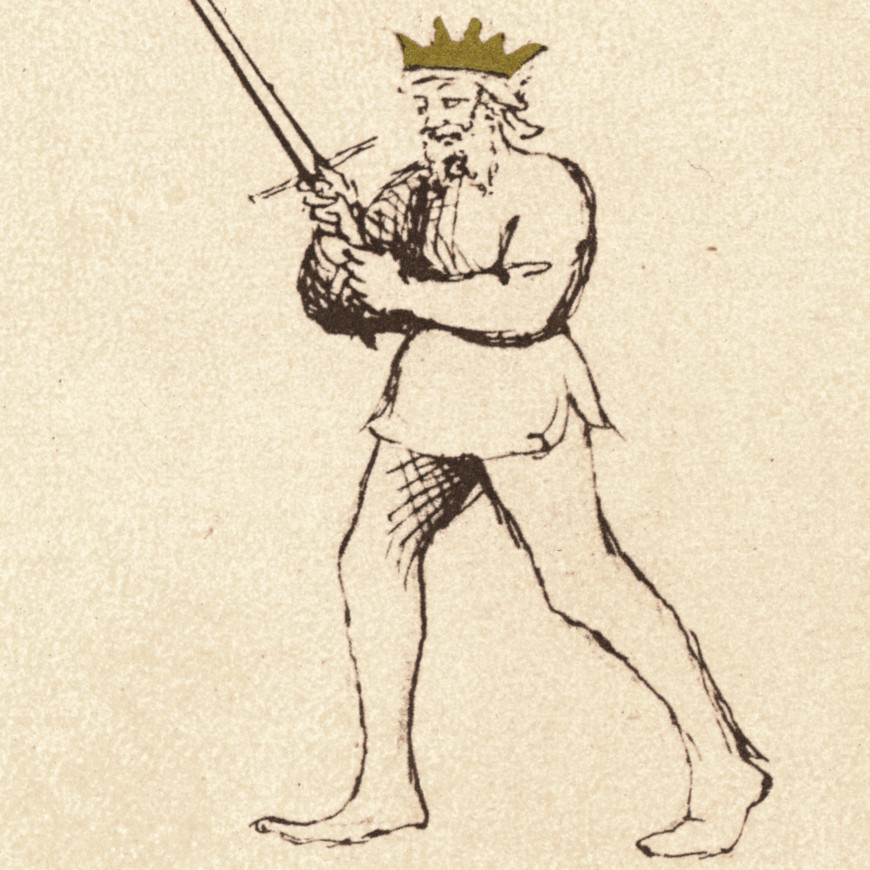 |
|
Also known as: posta frontale ditta corona ('frontal crown position')
Described by: Liechtenauer, Meyer, Fiore, Vadi
Kron ('crown') has the handle of the sword raised roughly in front of the face of teh fencer. As such, it is neither a good cutting nor a thrusting guard and not a good starting position for an exchange. It is nowever a good transient position for a parry and to initiate binds.
|
|
Alber
 |
|
Also known as: porta di ferro mezzana ('middle iron gate'), dente di cenghiaro ('boar's tusk')
Described by: Fiore, Liechtenauer, Meyer, Vadi
This is a family of low cutting guards in which the sword is held low, point forward and reasy for a false edge cut upward. At the same time, descending cuts typically end in such positions. Denta di cenghiaro tends to be closer to the body and tip forward, porta di ferro can be more forward and to the side, but differences are small.
The name Alber ('fool') probably comes from the fact that the guard seemingly leaves the head exposed, 'boar's tusk' describes the upward motion such a tusk makes when attacking. As for the 'iron gate', see Schrankhut.
|
|
Eisenport
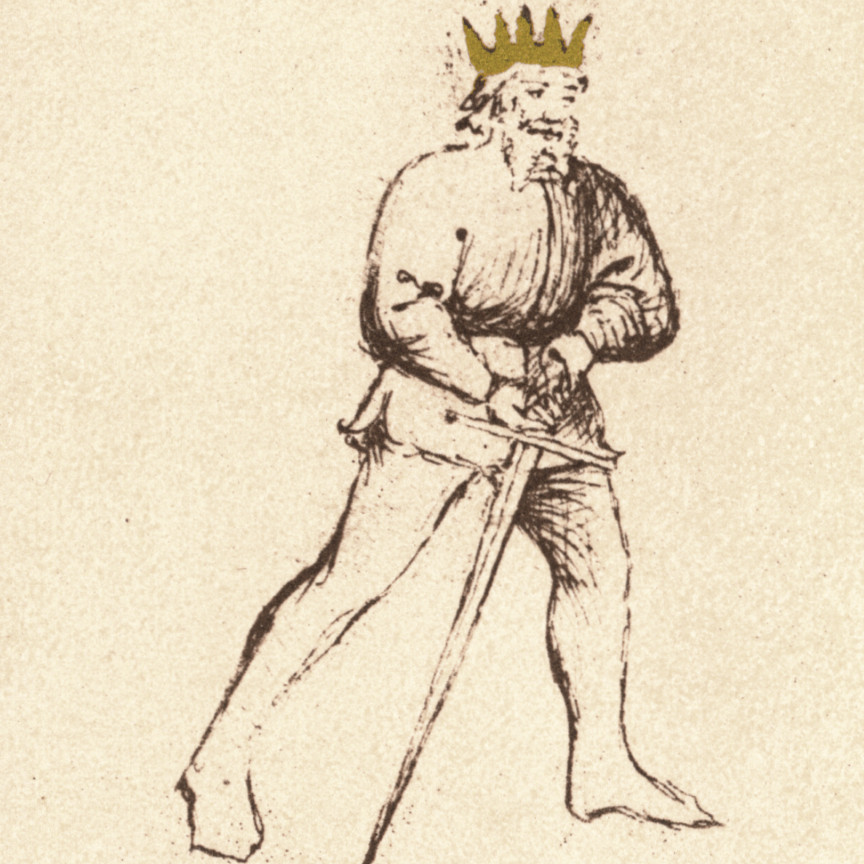 |
|
Also known as: tutta porta di ferro ('full iron gate'), posta di choda longa ('long tail'), Wechsel ('change')
Described by: Fiore, Meyer, Vadi, Paurenfeyndt
Low cutting guards with the tip pointed sideways or as a named variant even backward are different from the Alber family because they allow a true edge upward cut (or a Krumphau. For that reason, they are classified here as a separate guard.
The idea of the iron gate is apparent when considering the action of 'closing the gate', i.e. bringing the blade up to vertical with tip upward roughly over the forward knee (this is in fact how Meyer describes the guard as the endpoint of the motion rather than the starting point as Fiore does).
|
|
Eisenport (endpoint)
 |
|
Also known as: tutta porta di ferro ('full iron gate')
Conflicting name: posta di dona (Vadi)
Described by: Fiore, Meyer, Vadi, Paurenfeyndt
Meyer actually describes a sword that is held vertically above the knee (which Vadi calls, confusingly enough posta di dona) as Eisenport. On first glance, this seems rather different to the above, but as already mentioned this seems to be the endpoint of 'closing the gate'.
|
|
Schrankhut
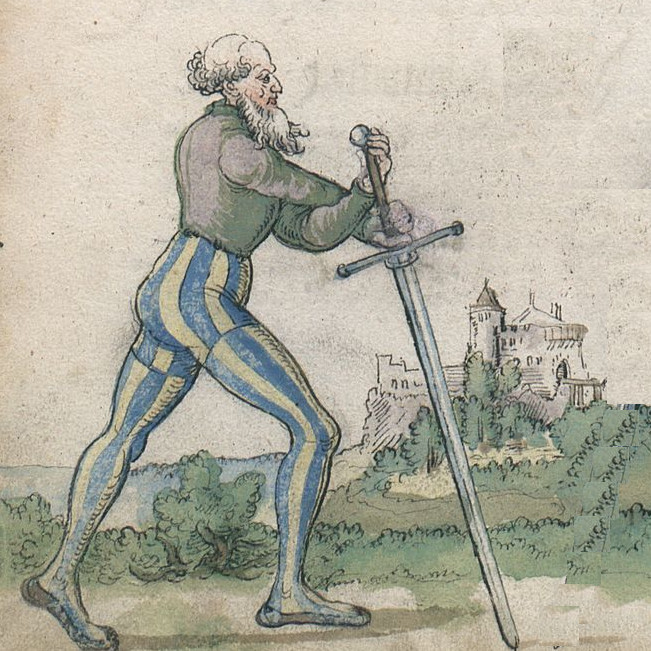 |
|
Described by: Liechtenauer, Meyer
Conflicting name: Eisern Pforten, Zwir (Paurenfeyndt)
Schrankhut, the 'barrier guard', appears to be done by placing the tip of the sword into the ground in front of the fencer with hands crossed, thus providing protection against low cuts.
Meyer shows the feet position reversed in this illustration, however the hands are still crossed. This particular guard doesn't seem to be much used in modern HEMA.
|
|
Pflug
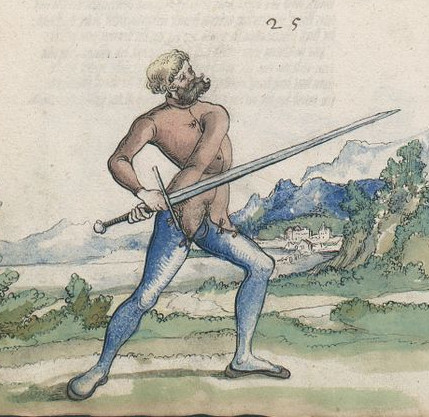 |
|
Described by: Liechtenauer, Meyer
Pflug ('plough') is a low thrusting guard of the Liechtenauer system where the sowrd is held at the hip with the tip pointing towards the opponent. The guard seems to be absent in the Italian system.
The origin of the name isn't quite clear, perhaps it is some similarity with a ploughshare.
|
|
Vom Tag
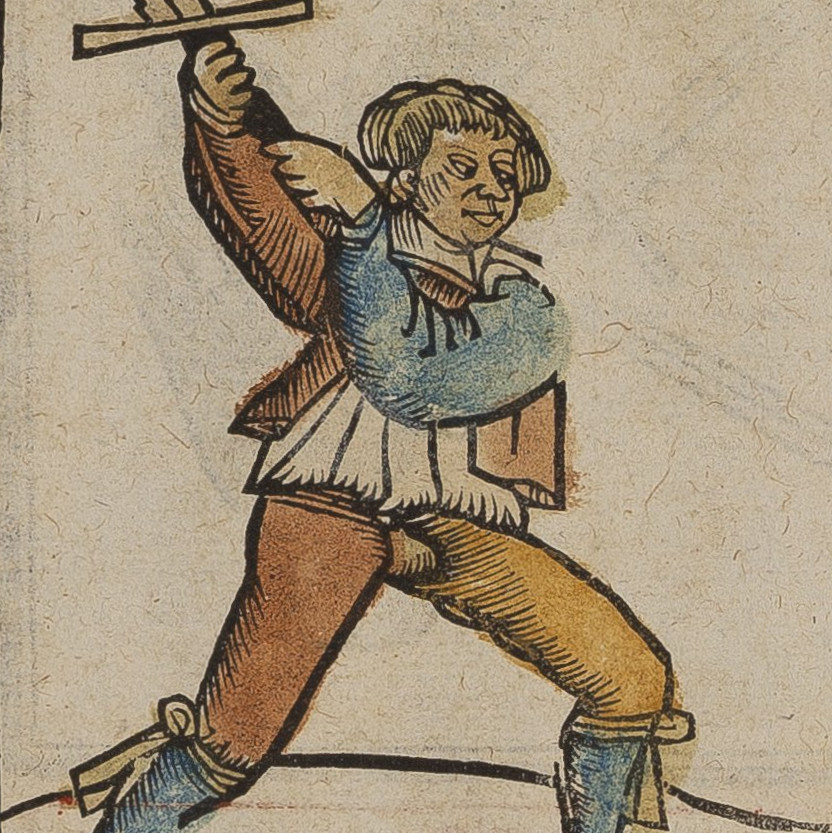 |
|
Also known as: posta di falcone ('position of the hawk'), Hochort ('high point')
Described by: Liechtenauer, Meyer, Vadi, Paurenfeyndt
Conflicting name: Ochs (Paurenfeyndt)
Vom Tag, the meaning being almost certainly 'from the roof', is a high cutting guard in which the sword is held either next to the head pointing upward or above the head but not pulled back onto the shoulder like in Zornhut. The guard thus lacks the spring-like ability to pulse into it and out again but offers more flexibility as to the direction of the intended cut.
|
|
Original quotes (English translation from the German by myself, from the Italian by Guy Windsor):
(1) SO vil nun aber die Leger belanget, so wil ich nicht das mann in deren einem lang verharre
(2) Io son posta di donna e non son vana, Che lungeza di spada spesso inghana
(3) Io son la posta di vera finestra, Leva de l’arte la cossa sinestra
(4) Das erst gleger wirdt genant hochort oder ochs als die alten wellen
Back to main index Back to Swordfighting
Created by Thorsten Renk 2025 - see the disclaimer, privacy statement and contact information.
|













